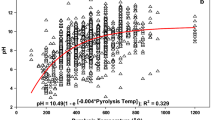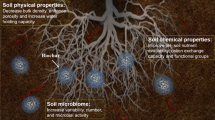Abstract
Forage nitrogen concentrations, nitrogen yields, and in vitro digestibilities were assessed in shortgrass steppe that had been ungrazed, lightly, or heavily grazed for 50 years. Caged plots were defoliated in amounts based upon removals observed in naturallygrazed reference plots or not defoliated. This was done in a year of average precipitation and with a supplemental water treatment to simulate a wet year. In general, current-year defoliation had positive effects, and longterm grazing and supplemental water had negative effects, on forage nitrogen concentrations and digestibilities. However, defoliation interacted with long-term grazing in determning forage nitrogen concentrations, and with grazing and with watering in determining digestibilities. Nitrogen concentration and digestibility increased with defoliation in lightly, but not in heavily, grazed treatments. The dilution effect of supplemental water an digestibilities through increased plant growth was offset by defoliation. The negative effects of long-term grazing on forage quality were small, equally or more than compensated for by defoliation in a year of average precipitation, but more pronounced in the simulated wet year. Nitrogen yields and digestible forage production were usually increased by defoliation, but this depended upon grazing and watering treatments. Increased nitrogen and digestible forage yields and concentrations in response to defoliation were greater than the biomass response in lightly grazed grassland. For both nitrogen and digestibility, yields were greater in grazed than ungrazed treatments in the year of average precipitation, but less in the simulated wet year. Optimizing quantity and year-to-year stability of nitrogen and digestible forage yield may best be achieved with light grazing rather than no or heavy grazing. Clipping was conducted in a manner closely resembling the natural pattern and intensity of defoliation by the cattle, and confirms the potential for a positive feedback of increased forage quality with defoliation observed in pot experiments. Long-term heavy grazing can diminish this response. Quantily (aboveground primary production, ANPP), quantity of quality (digestible and N yields), and quality (concentrations) do not necessarily respond similarly in interactions between current-year defoliation, long-term grazing history, and level of water resource.
Similar content being viewed by others
References
Adamski JM (1976) Simplified Kjeldahl determination for sea water by a semi-automated digestion method. Anal Chem 48:1194–1197
Ammann AP, Cowan RL, Mothershead CL, Baumgardt BR (1973) Dry matter digestibility and enrgy intake in relation to digestibility in white-tailed deer. J Wildl Manage 37:195–201
Baker JN, Hunt OJ (1961) Effects of clipping treatments and clonal differences on water requirement of grasses. J Range Manage 14:216–219
Chapin III FS, McNaughton SJ (1989) Lack of compensatory growth under phosphorus deficiency in grazing-adapted grasscs from the Serengeti Plains. Oecologia 79:551–557
Cook CW, Harris LE (1968) Nutritive value of seasonal ranges (Agrleultural experimental station bulletin 472). Utah State University, Logan
Coppock DL, Detling JK, Ellis JE, Dyer MI (1983a) Plant-herbivore interactions in a North American mixed-grass prairie. I. Effects of black-tailed prairie dogs on intraseasonal aboveground plant biomass and nutrient dynamics and plant species diversity. Oecologia 56:1–9
Coppock DL, Ellis JE, Detling JK, Dyer MI (1983b) Plant-herbivore interactions in a North American mixed-grass prairie. II. Responses of bison to modification of vegetation by prairie dogs. Oecologia 56:10–15
Coughenour MB, McNaughton SJ, Wallace LL (1985a) Responses of an African graminoid (Themeda triandra Forsk.) to frequent defoliation, nitrogen, and water: a limit of adaptation to herbivory. Oecologia 68:105–110
Coughenour MB, McNaughton SJ, Wallace LL (1985b) Responses of an African tall-grass (Hyparrhenia filipendula Stapf.) to defoliation and limitations of water and nitrogen. Oecologia 68:80–86
Coughenour MB, Detling JK, Bamberg IE, Mugambi MM (1990) Production and nitrogen responses of the African dwarf shrub Indigofera spinosa to defoliation and water limitation. Oecologia 83:546–552
Dean RE, Strickland MD, Newman JL, Thorne ET, Hepworth WG (1975) Reticulo-rumen characteristics of malnourished mule deer. J Wildl Manage 39:601–604
Detling JK (1987) Grass responses to herbivory. In: Capinera JL (ed) Integrated pest management of rangeland: a shortgrass prairie perspective. Westview, Boulder, pp 56–68
Fryxell JM (1991) Forage quality and aggregation by large herbivores. Am Nat 138:478–498
Hyder DN, Bement RE, Remmenga EE, Hervey DF (1975) Ecological responses of native plants and guidelines for management of shortgrass range (USDA-Agric Res Serv, Tech Bull 1503). US Government Printing Office, Washington D.C.
Jaramillo VJ, Detling JK (1988) Grazing history, defolion, and competition: effects on shortgrass production and nitrogen accumulation. Ecology 69:1599–1608
Klipple GE, Costello DF (1960) Vegetation and cattle responses to different intensities of grazing on shortgrass ranges on the central Great Plains, (USDA Tech Bull 1216). US Government Printing Office, Washington D.C.
Lauenroth WK, Milchunas DG (1991) Short-grass steppe. In: Coupland RT (ed) Natural grasslands, introduction and western hemisphere. (Ecosystems of the world 8A). Elsevier, Amsterdam, pp 183–226
Lauenroth WK, Sala OE (1992) Long-term forage production of North Amercian shortgrass steppe. Ecol Applic 2:397–403
Lauenroth WK, Dodd JL, Sims PL (1978) The effects of waterand nitrogen-induced stresses on plant community structure is a semiarid grassland. Oecologia 36:211–222
Lauenroth WK, Milchunas DG, Dodd JL, Hart RH, Heitschmidt RK, Rittenhouse LR (1994) Grazing in the Great Plains of the United States. In: Vavra M, Laycock WA (eds) Ecological implications of livestock herbivory in the west (AIBS symposium San Antonio, Texas, 1991). Society for Range Management, Denver, Colorado, pp 69–100
Le Houerou HN (1984) Rain use efficiency: a unifying concept in arid-land ecology. J Arid Environ 7:213–247
Le Houerou HN, Bingham RL, Skerbek W (1988) Relationship between the variability of primary production and the variability of annual precipitation in world arid lands. J Arid Envirorn 15:1–18
Lightfood DC, Whitford WG (1990) Phytophagous insects enhance nitrogen flux in a desert creosotebush community. Oecologia 82:18–25
McNaughton SJ (1984) Grazing lawns: animals in herds, plant form, and coevolution. Am Nat 124:863–886
McNaughton SJ (1992) Laboratory-simulated grazing: interactive effects of defoliation and canopy closure on Serengeti grasses. Ecology 73:170–182
McNaughton SJ, Chapin III FS (1985) Effects of phosphorus nutrition and defoliation on C4 graminoids from the Serengeti Plains. Ecology 66:1617–1629
McNaughton SJ, Wallace LL, Coughenour MB (1983) Plant adaptation in an ecosystem context: effects of defoliation nitrogen, and water on growth of an African C4 sedge. Ecology 64:307–318
McNaughton SJ, Ruess RW, Seagle SW (1988) Large mammals. and process dynamics in African ecosystems. BioScience 38:794–800
Milchunas DG, Baker DL (1982) In vitro digestion — sources of within- and between-trial variability. J Range Manage 35:199–203
Milchunas DG, Lauenroth WK (1993) A quantitative assessment of the effects of grazing on vegetation and soils over a global range of environments. Ecol Monogr 63:327–366
Milchunas DG, Lauenroth WK (1994) Primary productivity across fifty years of grazing intensity treatments in shortgrass steppe. J Range Manage 47:133–139
Milchunas DG, Dyer MI, Wallmo OC, Johnson DE (1978) Invivo/in-vitro relationships of Colorado mule deer forages (Special report no. 43). Colorado Division of Wildlife Ft. Collins
Milchunas DG, Sala OE, Lauenroth WK (1988) A generalized model of the effects of grazing by large herbivores on grassland community structure. Am Nat 132:87–106
Milchunas DG, Lauenroth WK, Chapman PL, Kazempour MK (1989) Effects of grazing, topography, and precipitation on the structure of a semiarid grassland. Vegetatio 80:11–23
Milchunas DG, Lauenroth WK, Chapman PL, Kazempour MK (1990) Community attributes along a perturbation gradient in a shortgrass steppe. J Veg Sci 1:375–384
Milchunas DG, Lee CA, Lauenroth WK, Coffin DP (1992) A comparison of 14C, 86Rb, and total excavation for determination of root distributions of individual plants. Plant Soil 144:125–132
Motazedian I, Sharrow SH (1990) Defoliation frequency and intensity effects on pasture forage quality. J Range Manage 43:198–201
Nelson DW, Sommers LE (1980) Total nitrogen analysis of soil and plant tissues. J Assoc Official Anal Chem 63:770–778
Painter EL, Detling JK, Steingraeber DA (1989) Grazing history, defoliation, and frequency-dependent competition: effects on two North American grasses. Am J Bot 76:1368–1379
Pieper R, Cook CW, Harris LE (1959) The effect of intensity of grazing upon nutritive content of diet. J Animal Sci 18:1031–1037
Polley HW, Detling JK (1989) Defoliation, nitrogen, and competition: effects on plant growth and nitrogen nutrition. Ecology 70:721–727
Rittenhouse LR, Roath LR (1987) Forage quality: primary chemistry of grasses. In: Capinera JL (ed) Integrated pest management on rangeland — a shortgrass prairie perspective. Westview, Boulder, pp 25–37
Ruess RW (1984) Nutrient movement and grazing: experimental effects of clipping and nitrogen source on nutrient uptake in Kyllinga nervosa. Oikos 43:183–188
Ruess RW (1988) The interaction of defoliation and nutrient uptake of Sporobolus kentrophyllus, a short-grass species from the Serengeti Plains. Oecologia 77:550–556
Ruess RW, McNaughton SJ, Coughenour MB (1983) The effects of clipping, nitrogen source and nitrogen concentration on the growth responses and nitrogen uptake in an East African sedge. Oecologia 59:253–261
Sala OE, Lauenroth WK, Parton WJ (1992) Long-term soil water dynamics in the shortgrass steppe. Ecology 73:1175–1181
Schwartz CC, Nagy JG, Rice RW (1977) Pronghorn dietary quality relative to forage availability and other ruminants in Colorado. J Wildl Manage 41:161–168
Senft RL, Rittenhouse LR, Woodmansee RG (1985) Factors influencing patterns of cattle grazing behavior on shortgrass steppe. J Range Manage 38:82–87
Tilley JMA, Terry RA (1963) A two-stage technique for in vitro digestion of forage crops. J Br Grassl Soc 18:401–411
Van Soest PJ (1982) Nutritional ecology of the ruminant. Cornell University Press, Ithaca
Varnamkhasti AS (1991) Aboveground production and rain use efficiency responses to long-term grazing, defoliation and rainfall. Thesis, Colorado State University, Fort Collins
Westoby M (1985) Does heavy grazing usually improve the food resource for grazers. Am Nat 126:870–871
Westoby M (1986) Mechanisms influencing grazing success for livestock and wild herbivores. Am Nat 128:940–941
Wilson JR (1984) Environmental and nutritional factors affecting herbage quality. In: Hacker JB (ed) Nutritional limits to animal production from pastures. Commonwealth Agricultural Bureaux, Slough, pp 111–131
Author information
Authors and Affiliations
Rights and permissions
About this article
Cite this article
Milchunas, D.G., Varnamkhasti, A.S., Lauenroth, W.K. et al. Forage quality in relation to long-term grazing history, current-year defoliation, and water resource. Oecologia 101, 366–374 (1995). https://doi.org/10.1007/BF00328824
Received:
Accepted:
Issue Date:
DOI: https://doi.org/10.1007/BF00328824




